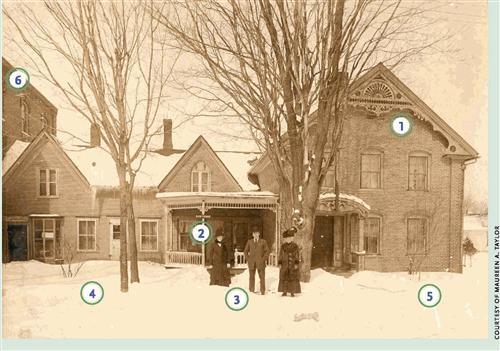Sign up for the Family Tree Newsletter Plus, you’ll receive our 10 Essential Genealogy Research Forms PDF as a special thank you!
Get Your Free Genealogy Forms
"*" indicates required fields

It’s a slice of Americana in almost every family photo album: A picture of the old folks standing in front of their home. Such portraits — whether they display pride in achieving the American dream or betray the photographic need for outdoor lighting — were all the rage, particularly in the late 19th century.
But nostalgic feelings aside, what can you learn from a photograph that reduces your great-aunt to the size of an ant? Plenty: Dwell on the right clues, and a homestead portrait forms a sturdy foundation for your family research.
No place like it
Look for hints to the home’s location in signs, nearby buildings and weather conditions. The deep snow and the ice dams on the roof suggest — but don’t guarantee — this house is in the northern United States. If this were your photo, you’d study your genealogical records for relatives who lived in locales with snowy winters.
Clothing probably won’t help date buildings in a photo, but it does give a time frame for the image. Use a photographer’s loupe or scan the photo at a high resolution and zoom in on the subjects’ outfits. Here, the woman on the left sports a long coat, scarf and feathered hat; the other woman poses in a shawl-collared fur coat and puffy toque hat. From 1900 to about 1905, women wore winter hats trimmed with large feathers and even fake birds, just like these ladies.
Exterior design
Even a novice house historian can decipher a dwelling’s architectural style — and thus, the time period — based on key features such as the roof, windows, doors, porches and trim. Compare them to illustrations in A Field Guide to American Houses by Virginia and Lee McAlester (Knopf, $24.95) or Identifying American Architecture: A Pictorial Guide to Styles and Terms, 1600-1945 by John J.G. Blumenson (W.W. Norton & Co., $15.95). For example, the trim along this roof edge is characteristic of Gothic Revival design, popular from 1840 to 1880 (with most structures dating before 1870). Andrew Jackson Downing’s 1850 pattern book The Architecture of Country Houses (Dover Publications, $16.95) contributed to Gothic Revival’s popularity in rural areas.
Home rooms
In an interior shot, fireplace mantels, floors and built-in furniture reveal when a house was built. Compare them to drawings in The Elements of Style: An Encyclopedia of Domestic Architectural Detail edited by Stephen Calloway (Firefly Books), which shows hundreds of exterior and interior details — everything from kitchen stoves to bathroom fixtures — for American and English homes.
Home decor is like clothing: It can help you date a photo, but not necessarily a house. You’ll find photos of well-appointed rooms in The Tasteful Interlude: American Interiors Through the Camera’s Eye, 1860-1917, 2nd edition, by William Seale (AltaMira Press). Notice an interesting piece of furniture tucked in the corner? Look for a similar one in Identifying American Furniture: A Pictorial Guide to Styles and Terms Colonial to Contemporary by Milo M. Naeve (W.W. Norton & Co.).
Sign of the times
A sign on this home’s porch railing names someone who probably worked or lived here. If you can spot a house number or street sign in your ancestral home photo, or you know who lived there, check local city directories for the address, residents’ occupations, and neighbors’ names. Some directories indicate whether residents own or rent (bds means boards); the former should send you to the county clerk in search of a deed and property tax records. Learn more about researching houses in Discovering the History of Your House and Your Neighborhood by Betsy J. Green (Santa Monica Press).
1. Roof positive. Laceworktrim identifies this house as Gothic Revival.
2. Sign language. This placard could bear a resident’s name.
3. House of fashion. Clothing dates the photo, not the building.
4. Snow day. Weather can indicate where a picture was taken.
5. Land, ho. Search land and tax records for more house details.
6. Good neighbor. Look for architectural clues on any next-door buildings, too.
From the August 2006 issue of Family Tree Magazine.
ADVERTISEMENT

